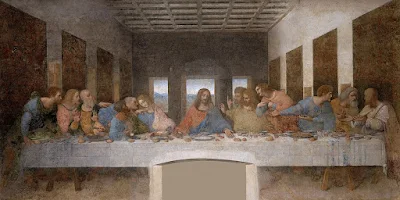- Leonardo DA Vinci (Italian: "Leonardo from Vinci") (April 15, 1452, Anchiano, near Vinci, Republic of Florence [Italy]—May 2, 1519, Cloux [now Clos-Lucé], France), Italian painter, draughtsman, sculptor, architect and engineer who, perhaps more than any other figure, epitomized the Renaissance humanist ideal. Two of the Renaissance's most well known and important paintings are His Last Supper (1495–98) and Mona Lisa (c. 1503–19). His diaries reveal a scientific curiosity and mechanical prowess millennia before their time.
Mona Lisa
- The Mona Lisa is an Italian artist, Leonardo DA Vinci's half-length portrait painting. It has been dubbed "the world's most famous, most visited, most written about, most sung about, and most parodied work of art."
- It has been called "the world's most famous, most visited, most written about, most sung about, and most parodied work of art."
- The Mona Lisa established the standard for all portraiture after that.
- The painting depicts a woman who was recognized as Lisa del Giocondo, the Florentine merchant Francesco del Giocondo's wife, in the twenty-first century, hence the work's alternate title, La Gioconda.
- The photo portrays a half-body portrait of the individual against a distant country side backdrop.
- Leonardo's emotive synthesis of the sitter and the setting has sealed this work's place among the most popular and researched paintings of all time, while using a pretty basic portraiture method. The sensuous curves of the woman's hair and attire are repeated in the undulating valleys and rivers behind her.
- The painting's overall harmony, which can be seen in the sitter's small smile, embodies Leonardo's concept of a cosmic link uniting people and nature, making it an enduring legacy of Leonardo's vision and brilliance. Raphael drew the work in progress when he was young, and it became the foundation for his Portrait of Maddalena Doni (c. 1506).
The Last Supper
- The Last Supper is a late-15th-century fresco by Leonardo DA Vinci that may be found in the refectory of the Santa Maria delleGrazie monastery in Milan, Italy. It is one of the most well-known paintings in Western culture. The Last Supper (1495-1498) by Leonardo da Vinci is one of the most iconic paintings in the world. The scene's conception is excellent in its mammoth simplicity; the impact is amplified by the startling contrast in the 12 disciples' attitude as a counterbalance to Christ.
- At Easter, while Jesus was gathered by the apostles, Leonardo described a tense time when Jesus said, "One of you will betray me." As people who don't comprehend what's going on,
- "All the apostles are delighted as people who don't understand what's going to happen, while only Christ, cognizant of his heavenly purpose, sits in a lonely and transfigured serenity; only one other being shares the secret knowledge: Judas, who is both part of and excluded from his colleagues' movement." He becomes society's second lonely character, the perpetrator, as a result of his solitude.
- Leonardo achieved a level of expression that has stood the test of time. Many later painters, including renowned masters like Rubens and Rembrandt, were affected by Leonardo's composition and narrative quality. Some Goethe's most beautiful pages of descriptive prose.
- It was universally acknowledged thanks to numerous replicas and engravings, the most famous of which being Raffaello Morghen's in 1800.
- The Last Supper is thus a part of humanity's common legacy, and it remains one of the most important in the world to this day.
- Outstanding works of art.
- The work's fame was not diminished by technical shortcomings in its execution. Leonardo was unclear about the technique to use and chose another over the usual fresco painting, which requires swift and uninterrupted painting because it is constructed of fresh plaster.
- He'd honed his technique of annealing on a basis he'd mixed himself throughout the stone wall. This method failed because the base broke loose from the wall very quickly. The work was dubbed a ruin in the early 16th century.
- Improper restoration attempts later exacerbated the problem, and the degradation did not end until after World War II, when more sophisticated restoration procedures were used.
- The restoration campaign, which lasted from 1980 to 1999, restored the works' luster while also revealing that very little original paint remained.



No comments:
Post a Comment
Your Comments